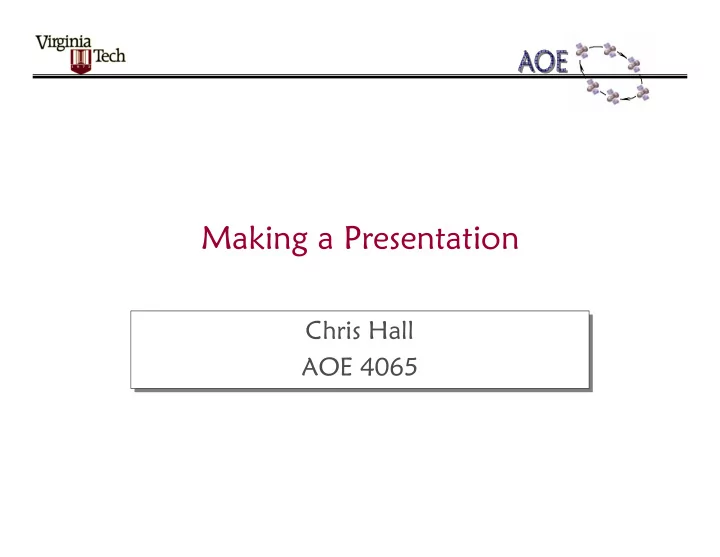

Making a Presentation Chris Hall Chris Hall AOE 4065 AOE 4065
Overview • Organizing the presentation • Organizing the presentation • Formatting the presentation • Formatting the presentation • Giving the presentation • Giving the presentation • For a short presentation, an overview might • For a short presentation, an overview might not be needed not be needed • In that case, a good motivation slide is useful • In that case, a good motivation slide is useful
Organizing • Know your audience • Know your audience – Level of expertise – Level of expertise – Knowledge about specific topic – Knowledge about specific topic • Know how long you’re supposed to talk • Know how long you’re supposed to talk – Talk no longer – Talk no longer – Leave time for questions – Leave time for questions – Roughly 1 slide per 1-2 minutes – Roughly 1 slide per 1-2 minutes • Tell them what you’re going to tell them, tell • Tell them what you’re going to tell them, tell them, and then tell them what you told them them, and then tell them what you told them – Title slide – Title slide – Overview slide – Overview slide – Summary slide – Summary slide – (don’t do this if it’s a short presentation) – (don’t do this if it’s a short presentation)
Formatting • Prepare all the slides using a consistent style • Prepare all the slides using a consistent style • Make sure the fonts are large enough to read • Make sure the fonts are large enough to read from the back of the room (18+ points, NOT 12 ) from the back of the room (18+ points, NOT 12 ) • Don’t use too many equations • Don’t use too many equations • Don’t make your slides too wordy • Don’t make your slides too wordy • Make your graphics, especially drawings, as • Make your graphics, especially drawings, as clear and legible as you can clear and legible as you can • Always use leading zeros in numbers • Always use leading zeros in numbers 0.12 NOT .12 0.12 NOT .12 • Don’t use too many decimal places • Don’t use too many decimal places 15 m 2 NOT 15.0369268 m 2 15 m 2 NOT 15.0369268 m 2
Figures roll, pitch, and yaw angles of F b with respect to F o 90 50 θ 1 θ 2 40 θ 3 60 30 30 20 latitude, δ 10 0 0 −10 −30 −20 −60 −30 −40 −90 0 60 120 180 240 300 360 −50 0 0.2 0.4 0.6 0.8 1 1.2 1.4 longitude, L time (orbital periods) Which is better?
Presenting • Introduce yourself • Introduce yourself • Introduce your presentation • Introduce your presentation • Give your overview or motivation • Give your overview or motivation • Give the main body of the talk • Give the main body of the talk • Don’t stand beside the projector • Don’t stand beside the projector • Don’t “throw slides away” • Don’t “throw slides away” • Don’t stomp or slap your thigh • Don’t stomp or slap your thigh • Don’t say uh or um or ah too much • Don’t say uh or um or ah too much • Don’t use vague adjectives • Don’t use vague adjectives • Give your summary and closing • Give your summary and closing
After Closing • Your last slide shouldn’t be the “Click to • Your last slide shouldn’t be the “Click to restart presentation slide” restart presentation slide” • Offer to take questions • Offer to take questions • Repeat the question if your questioner is too • Repeat the question if your questioner is too quiet quiet • Answer questions clearly, loudly, and honestly • Answer questions clearly, loudly, and honestly • Don’t be afraid to say “I don’t know” • Don’t be afraid to say “I don’t know” • In team presentations, STAND UP to answer • In team presentations, STAND UP to answer questions questions
Recommend
More recommend